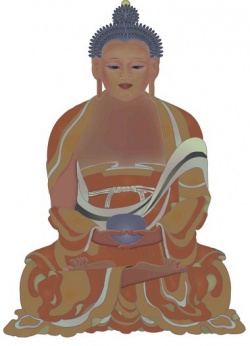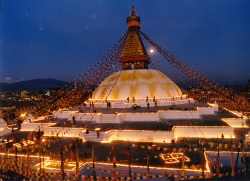What is visualization meditation?
What is visualization meditation? It is the focusing of our attention upon a visual object. Visualization is one of the most popular and potent forms of meditation. More than just an inner technique, it can directly affect the conditions of our outer world.
We gain benefits from visualization. From one perspective, visualization is simply another form of meditation; we are gazing upon an internal image rather than concentrating on the outer image of a candle, for example. But visualization presents some unique benefits:
It gives us more freedom to select the images upon we concentrate. We can imagine seeing any spiritual teacher, or any scene, or any object, without having to possess that physical image to view. Thus we have an unlimited repertoire of images -- anything which can be conceived -- so we can select one which more-accurately represents (and can transmit the power from) a particular state which we want to experience.
These internal images might be more powerful than external ones because they are linked directly to the state which they represent. For instance, in mandala meditation, we look at the mandala in order to internalize its dynamics as its elements would correspond to our psychological elements, but in simple visualization, the image is already internal; we eliminate the step of internalization during which some of the energy might be lost. Images -- rather than words -- are the native language of the unconscious mind and other parts of ourselves; in visualization, we can communicate more effectively with these parts -- in the same way, conversely, that the unconscious mind attempts to communicate with the conscious mind via the imagery-language of dreams.
When we develop our visualization skills in meditation, we can use the skills for archetypal field-work ("directed imagination").
We can consider these guidelines for visualization techniques.
We use the guidelines that are in the chapter regarding visualization. Many of them will be applicable when we are using visualization as a type of meditation. To avoid redundancy, those guidelines have not been repeated here.
Choose an active or passive approach. In the active approach, we generate a specific image toward which to direct our attention. The passive approach is to focus on the black screen of the mind and then allow any images to appear; we might start with a particular image and then allow others to arise in response to it in a type of "story" like that of a dream (and we might then do an interpretation of that story in the same manner in which we would interpret dream symbolism). Both the active and passive methods can be useful in the development of our visualization skills.
Be able to experience the state without the image. In any visualization, no matter what image we use, we are attuning to the state which is represented by that image; a step beyond visualization techniques is to be able to achieve that state without the use of an image.
Experiment with various techniques. In addition to the techniques which are in the chapter regarding visualization, we can use these:
Do some visualizations with "spiritual light." Imagine light coming in through the top of the head (through the crown chakra) and circulating throughout every part of the body. Or imagine light surrounding your body and your home. Or visualize light coming in with every inhalation; on the exhalation, we might visualize light going out to the world, or we might prefer to see our unwanted traits being expelled on that out-breath. Or imagine light surrounding your spine and each of the chakras. Or visualize light being directed to a particular part of your body, perhaps a part which is injured or ill. Or imagine various objects which radiate light: a star, a sunrise, a campfire. Experiment with different colors of light, to see how they affect you and the visualization process; some people experience the greatest spiritual awakening with the colors of gold, white, or blue.
Combine visualization with movement meditation. For example, as we walk, we can visualize ourselves as a leaf being carried by a breeze or by a river's current.
Stimulate the spiritual eye. Instead of creating a visual image somewhere else on the black screen of the mind, create it in the location of the spiritual eye (which is also called the third eye). This is approximately one inch above the midpoint between the eyebrows, and set back in the head a couple of inches. When we focus our attention on this spot, the energy of our attention is likely to help the spiritual eye to "open." Then we might see light -- perhaps just sparkles or splotches of white light at first. (Don't look directly at the images; this can cause them to disappear.) As this non-physical organ becomes activated further, we might see images which are more distinct; these images can include scenes from the astral plane or another world -- maybe a flower or a landscape or a blue star.
Visualize a religious symbol. This can be a crucifix, or an image of a saint's face, or an animated scene from a religious story.
Merge with the image. Create an image of light (as in a candle or the sun), or an image of a mandala or a spiritual teacher or something else that has qualities which you want to develop. Then slowly attract that image toward you, and feel its qualities and energy merging with yours. We can experience this merging in different ways: (1) an interaction between ourselves and the image, or (2) a state in which both we and the image become less prominent and what is experienced most strongly is the impersonal energy (the energy underlying those qualities existing in us and in the image) in a field of its own; at this point, the "duality" between ourselves and the object is simply an interplay of complementary forces, each existing in relation to the other, drawn from the same field of potential for this moment of interaction, then to revert back to that field.




